I recently purchased a box of pillar candles for my projects. With the heat of the summer upon us, I was wondering if the candles would melt if I left them in my car.
I know that the temperature inside of a car can get very high in the summer. We hear all about it on the news during those heat waves.
Plus, with my recent shopping experience, I wondered if I had left the candles in my car, would they have melted? How long would the candles have to sit in my car, before they started melting?
I did some online research to find out.
Will candles melt in a hot car? Yes, candles can melt in a hot car, but how long it takes depends on the type of candle wax and the temperature inside the vehicle. Wax melts between 99-145 °F and the temperature inside of a vehicle can be 130-170 °F. A candle left in a hot car can melt within 25 minutes to 2 hours.
How long it takes a candle to melt in a hot car depends on a variety of factors, with candle wax type and vehicle temperature only being two.
Melting Temperatures of Different Types of Candle Wax
Different waxes melt at different temperatures. Paraffin wax has the lowest melting point temperature between 99-130 °F and beeswax has the highest melting point temperature at 145 °F. Soy wax is somewhere in the middle with a melting point temperature of 120 °F.
Therefore, if you leave a paraffin wax candle in your car on a hot summer day, it won’t take long for it to melt into a puddle of goo. However, if you have a beeswax candle, you may be able to save the candle from a melty demise.
One important point to note is that there is low melting paraffin wax and high melting point paraffin wax. So, depending on which type of paraffin wax the candle is made of, it may not take long for the candle to start melting.
The low melting paraffin wax has a melting point typically less than 130 °F and the high melting point paraffin wax typically has a melting point between 130-154 °F.
If you would like to see the type of paraffin pillar candles I buy and the other types of waxes I use to create my candles, you can check out my recommended products page.
How Hot It Gets in a Car and the Factors that Influence Temperature
The temperature inside a vehicle can get up to 130-170 °F, when the air temperature outside is 80-100 °F.
There are a variety of factors to consider determining how quickly a car will heat up and a candle will melt. The temperature inside the vehicle is, of course, the primary factor for how quickly a candle will melt. The inside temperature is most dependent on the outside temperature, but there are other factors at play that can influence the temperature inside a vehicle.
The temperature inside the car also depends on where the car is parked. If the car is parked in direct sunlight, the car will heat up much more quickly. If the car is parked in shade, the car will take longer to heat up.
Also, whether the windows on the car are tinted or not will determine how quickly a car will heat up. Tinted windows are designed to either reflect or absorb UV light, which helps to prevent the temperature inside of the car from skyrocketing.
The color of the interior of the vehicle will also play a role in the temperature variant. Dark vs. light dashboard, seats, etc. will impact how quickly the car heats up. Light colors, especially white, reflect light. Dark colors, especially black, absorb all light. Therefore, a dark dashboard or seat will heat up more quickly than a light colored one. A black dashboard can heat up to 180-200 °F.
These objects heat the adjacent air by conduction and convection. Conduction describes how the molecules of a solid object move faster when heated. Convection occurs in fluids (such as air) by the motion of the molecules. An increase in temperature causes molecules to move faster.
One last determining factor of vehicle temperature is if there is a refractory shade placed behind the windshield. This shade would help reflect the heat and slow the warming of air within the vehicle.
Graph Showing the Rate of Temperature Increase Inside of a Vehicle Based on Outside Temperature

Source: https://www.weather.gov/lsx/excessiveheat-automobiles
One factor that does not seem to matter, or has minimal impact, is whether the windows are cracked, or rolled down an inch or so. It appears whether the windows are rolled all the way up or cracked open a bit has minimal impact on the rising temperature.
Graph Showing the Rate of Temperature Increase Inside of a Vehicle Based on Closed Vs. Cracked Windows

Source: https://www.weather.gov/lsx/excessiveheat-automobiles
How Long Would It Take For a Candle To Start Melting
There have been times when I purchased candles and left them in my car to continue my shopping. I recently paid a visit to an outlet mall shopping center and purchased a couple of candles I ordered on-line. After I went to pick them up, I dropped them off in my car, and decided to continue shopping.
Not only does melt rate depend on the candle wax type and the temperature inside the vehicle, but the size and type of the candle will also be a factor. For example, a small, votive candle, will melt much more quickly than a 4×9 inch pillar candle. Also, whether it is a tealight candle vs. a pillar candle, will determine how quickly the candle will melt.
It could only take 25 minutes for a paraffin wax candle to start melting, because the temperature inside the car could be 100 °F when the outside temperature is only 73 °F.
Another factor that determines how quickly a candle would melt in a hot car would be the packaging of the candle. What was it packed in? Plastic, wax paper, cardboard box, etc.
If your candle is wrapped in plastic, determining if the candle will melt more quickly because of its packaging, depends on the type of plastic wrap. Some thinner plastic wrap would probably melt easily. Other types of thicker plastic would withstand higher temperatures.
Some plastic wrap is designed to withstand high heat, up to 212 °F, which is the boiling point of water. Certain kinds of plastic wrap, especially the type used for cooking, will not melt unless it gets to 220-250 °F.
Therefore, it is safe to say that if you wrap a candle in kitchen plastic wrap, you don’t have to worry about it heating up the candle and melting it. The plastic melting due to the hot temperature of the car is not likely to happen.
Wax paper has a coating which makes it moisture-resistant, but wax paper is not heat-resistant. The wax coating, made of wax, will melt just like the candle. Therefore, you will end up with an extra layer or covering of wax on your candle, if your candle is packaged or wrapped in wax paper.
Cardboard is a great insulator. Egg cartons work great to store small votives or tealights. Cardboard will help keep your candles cool and prevent melting.
How to Increase the Chances of a Candle Surviving in a Hot Car
There are some additives that can be added to a candle to protect them from the damaging rays of the sun. Ultraviolet Light Absorbers (UVLA’s) are additives, which can reduce fading. A good, humorous analogy I found was that UVLA’s are like “sunscreen for your candles.”
Stearic acid is another additive that can increase the melting point of lower melt point waxes, such as paraffin and soy. The melting point of stearic acid is 150 °F. There are two types of stearic acid, each specific for paraffin vs. soy wax.
Micro 180 is another additive that can increase firmness of the candle, which would work particularly well during those hot summer days.
Additives affect the burn properties of the candle. Although all of these additives are great solutions to lowering the possibilities of candles from melting in a hot car, it is important to note that the more additives to put into your candle, the more it will affect color, scent throw, and how the candle burns.
How to Wrap, Package, and Store a Candle So it is Less Likely to Melt
The best storage advice is to keep candles in a cool place or air-tight container out of direct sunlight or away from harsh light. Wrapping a candle in a cool package or material that does not absorb heat will help to decrease the chances of a candle melting in your car.
Based on my previous research, it sounds like wrapping your candle in a kitchen plastic wrap, used for cooking, and placing it into a cardboard box is the best option to help keep the candle cool, keep it from melting, and protect it from other wax, candles, or materials melting onto it.
If a candle does melt in your car, one positive or upside of this all is that your car is going to smell nice!



